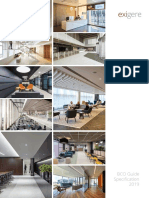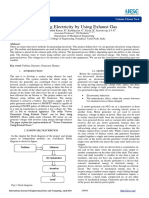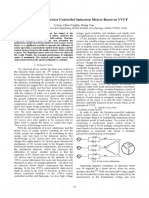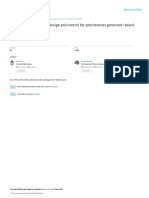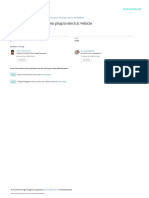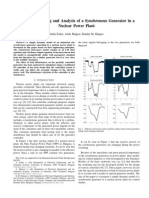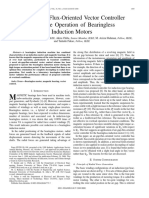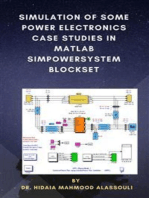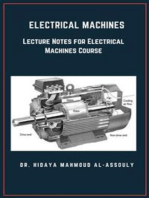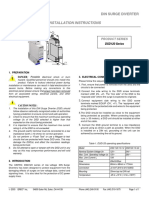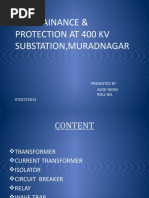Harmonic Analysis of DFIG Wind Turbine
Harmonic Analysis of DFIG Wind Turbine
Copyright:
Available Formats
Harmonic Analysis of DFIG Wind Turbine
Harmonic Analysis of DFIG Wind Turbine
Copyright
Available Formats
Share this document
Did you find this document useful?
Is this content inappropriate?
Copyright:
Available Formats
Harmonic Analysis of DFIG Wind Turbine
Harmonic Analysis of DFIG Wind Turbine
Copyright:
Available Formats
Volume 7, Issue 11, November – 2022 International Journal of Innovative Science and Research Technology
ISSN No:-2456-2165
Harmonic Analysis of DFIG Wind Turbine
1
Uriti Sai Abhishek, 2DR. T. R. Jyothsna
Andhra University College of Engineering, Andhra Pradesh, India
Abstract:- This proposal investigates the self-excitation I. INTRODUCTION
of the asynchronous generator while operating in an
isolated mode. With this research, we hope to improve Wind turbines include both mechanical and electrical
the quality of electrical energy produced under various components, therefore this chapter presents a dynamic
environmental conditions and to promote the use of model of the system to understand the dynamic performance
renewable energies throughout rural areas in order to of the system and to build a controller. To begin, the basic
better support rural areas in the areas of educational equations describe the machine's interaction between
advancement, clean water access, livestock and voltage and flux. The dynamic model may be derived from
agriculture development, and information and these simple equations. We have aerodynamic and
communication dissemination. The focus of this project mechanical component models as well. This approach also
is on the description and modeling of the wind turbine's explains the decoupling control of active and reactive
many mechanical components. In addition, the power. With this information, we can determine how to
asynchronous generator under self-excitation is modeled implement vector control in a way that maximizes efficiency
in steady-state and transient modes. In both vacuum and and minimizes power losses while still maintaining a stable
charge, test results and simulations have shown the voltage level in the grid. The grid-side converter has two
impact of the wind system's self-excitation capability on primary goals: control of the DC-link bus voltage and
its output quantities (voltage, current, and torque) control of the active and reactive powers transferred
(resistive and inductive). The amplitude, waveform, and bidirectionally between the machine's rotor and the grid.
frequency of the asynchronous wind turbine are imposed This control technique emphasizes these two goals. A
on the network when it is connected. The asynchronous complete assessment of the system's behavior is carried out
machine, on the other hand, has a low power factor, based on the final machine and control system equation
which indicates that it needs reactive energy at isolated modeling, resulting in performance curves that disclose the
spots. We may remedy this irregularity by employing current, voltage, or various magnitude needs, depending on
variable capacitors to increase the power factor. The the machine's unique operating circumstances. Using the
reactive power (excitation current) must be continuously Simulink model built in this chapter, the rotor position
provided in accordance with the connected load. This estimate and the performance comparison findings of the
necessitates the use of an intelligent energy management system under unbalanced dynamic behavior will be applied
system. to Chapters Four and Five, respectively.
At 3-10 mph dominating winds and 4-6mph II. DOUBLY-FED INDUCTION GENERATOR
average yearly wind speeds, the widespread use of 7– DYNAMIC MODEL
15meter diameter wind turbines (WT) is explored.
Power characteristics of WT may be generated using a The equivalent circuit of a DFIG shown in figure 3.1
technique that considers the distribution of wind flow may be described using a variety of various reference
and electric energy consumption patterns. We've frames, such as the stationary frame, the rotor frame, or the
investigated the frequency-controlled asynchronous synchronous frame oriented to either stator flux [22] or
generator wind turbine control algorithms to enable stator voltage [47]. Figure 3.2 of Chapter 3: Mathematical
rotor braking in partial loading, stabilizing nominal Model of DFIG System illustrates a simplified DFIG model
power, and complete stop modes. Analyzing the with three windings in each of the stators and rotors.
combined mechanical properties of a wind turbine and a Instantaneous voltages, currents, and flux for this machine
generator illustrates this strategy. Gain-frequency are as follows:
control and automated distribution of produced power
between self-contained power grid consumers and static
energy storage are discussed in this wind turbine control
system. Based on the generalized energy flow theory of
three-phase electromechanical converters, we present
approaches for optimizing generator operating modes.
Synchronous & Asynchronous generator
mathematical model system
Fig. 1: System configuration of the wind turbine
IJISRT22NOV1059 www.ijisrt.com 669
Volume 7, Issue 11, November – 2022 International Journal of Innovative Science and Research Technology
ISSN No:-2456-2165
III. VECTOR CONTROL SYSTEM Synchronous generator terminology differs from that
of a DC generator in that the machine's components are
Reactive power exchanged with the grid is controlled described using the opposite language. Field windings are
by the d-axis, which is normally set to zero to operate with a the windings that generate the primary magnetic field, while
unity power factor. Using an approach similar to the one armature windings are the windings that generate the main
used to manage the q-component, an error is formed when voltage, which is the stator windings in a synchronous
the measured reactive power is compared to the reference machine. There are two types of windings in the
reactive power, which is used to calculate the reference d- synchronous machine: field windings and armature
axis component of the rotor current. When the error is windings.
greater than or equal to zero, the d-axis component's
reference voltage may be determined by a second PI
controller. Finally, the PWM module is used to compute the
modulation indices needed to control the RSC, as illustrated
in figure 3.4. There are four PI controllers in the outer
control loop depicted in figure 3.4, which judged the rotor
currents and voltages in the inner control loop. The stator's
active and reactive power transmission functions.
Fig. 3: Synchronous Generator Construction
Using the two-pole wound prominent rotor in the
preceding example, we can see the fundamental building
blocks of a synchronous generator. In order to generate a
field current, this winding is coupled to a DC supply
voltage. An electromagnetic field with fixed North and
South poles is generated around the coil by an external DC
excitation voltage of up to 250 volts DC.
When the turbine blades turn the rotor shaft of the
generator, the rotor poles will also spin, creating a rotating
Fig. 2: Block diagram of RSC controller
magnetic field (assuming direct drive). Every time the rotor
IV. SYNCHRONOUS GENERATOR spins, an emf and a current are generated in the stator coils
as a result of the magnetic flux being cut through them one
A. Synchronous Generator as a Wind Power Generator by one by the rotor. Since the rotor's rotation speed,
According to the Wikipedia entry on this machine, it is a magnetic field strength, and the number of stator winding
rotating magnetic field on the rotor that generates electricity, turns all depend on the magnetic field's intensity, it's easy to
while the stationary stator has many windings to provide the see how stator winding turns to affect the voltage induced
created power. Excitation of the rotor's magnetic field is there. Stator windings A, B, and C, which are electrically
achieved either by mounting permanent magnets directly 120o apart, provide a three-phase voltage supply in the
onto the rotor or by energizing the rotor's field windings stator windings as illustrated in the diagram above.
with an external DC current.Slip rings and carbon or
graphite brushes are used to transfer the DC field current to Because the coils in this 3-phase stator winding are
the synchronous machine's rotor. Sophisticated synchronous fixed, they do not need to pass through massive, unreliable
generators are easier to build since they don't need slip rings, commentators, or carbon brushes on their way to
complicated commutation. As with an automobile alternator, the load. In addition, the lack of rotational and centrifugal
the synchronous generator has two common components: a forces in the windings makes it simpler to wound and
motor and an inverter. insulate them, resulting in higher voltages being produced.
Main Components of synchronous Generator B. Permanent Magnet Synchronous Generator
To produce an AC voltage, the stator physically and Wound-field synchronous machines need DC stimulation
electronically displaces three distinct (3-phase) armature in the rotor winding, as we've seen. On the generator shaft,
windings by 120 degrees. brushes and slide rings are used to excite it. However, there
Using slip rings and carbon brushes, the rotor connects to are a number of drawbacks, such as the need for regular
an external DC power supply through slip magnets or maintenance and the need to clear up carbon dust. Brushless
coiled field coils to carry the magnetic field. excitation, which utilizes permanent magnets rather than
electromagnets, is another option.
IJISRT22NOV1059 www.ijisrt.com 670
Volume 7, Issue 11, November – 2022 International Journal of Innovative Science and Research Technology
ISSN No:-2456-2165
C. The Generators Synchronous Speed As a result, the usage of a gearbox or pully system
Rotor speed and the number of magnetic poles on the needs frequent maintenance, which adds weight to the wind
rotor affect the output voltage's frequency, which is referred turbine; produces noise; increases power losses, and affects
to as "angular velocity." The synchronous machine has two system efficiency as more energy is needed to operate the
poles, a North pole and a South pole, as shown above. Two gearbox's gears and internal components.
poles (North-South) or one pair of poles (North-South) are
used in the machine. The absence of a mechanical gearbox in a direct drive
system has several benefits, but it necessitates a bigger
One cycle of induced emf is created for every 360o synchronous machine and a more expensive generator, both
rotation of the rotor, hence the frequency will be one cycle of which must run at low speeds. So, how can we run a
per entire revolution. It is possible to produce two more synchronous generator in a low-speed wind turbine system
induced emf cycle cycles for every rotor rotation by whose rotor blade speed is solely dictated by the wind's
increasing the number of magnetic poles to four (two pairs). power? This may be done by converting the 3-phase supply
into a continuous DC supply.
The number of induced emf cycles generated by a
single pair of poles, P, is consequently equal to the number D. Synchronous Generator Rectifiers
of pole pair revolutions produced by the rotor. This means When converting AC to DC, electronic devices called
that if we use P/2 for the number of cycles per revolution diode rectifiers are used (direct current). The synchronous
and N/60 for the number of rotations per second, we can get generator output may be rectified into a DC supply,
the frequency () of the induced emf as follows: allowing the wind turbine generator to operate at speeds and
frequencies other than the specified synchronous speed.
The variable frequency and changeable voltage output
of the generator may be used to create a variable DC
voltage. Once it's been converted from AC to DC, the
generator may be used to charge batteries or power a
If you're using 50Hz or 60Hz appliances, you'll need to variable-speed wind turbine. Alternator-generator is
keep the generator's speed constant at 50Hz or 60Hz in order subsequently transformed into the direct current generator.
to maintain the needed frequency of 50Hz or 60Hz for your
appliances. The rotor's mechanical rotation is synchronized Generator AC is converted to variable DC supply,
with the frequency of the emf generated. which in turn relies on the generator rotational speed,
through diode bridge circuits, which are the most
When employing a two-pole machine, the rotor must fundamental rectifier circuits. In this synchronous generator
revolve at 3600 revolutions per minute, whereas a four-pole rectifier circuit, a 3-phase rectifier converts the generator's
machine must rotate at 1500 revolutions per minute. In the three-phase output to direct current (DC).
case of a wind turbine synchronous generator, this
synchronous speed may not be attainable due to the
continuously changing wind speed and power. This may be
simple to accomplish with an electrical motor or steam
generator-driven synchronous generator. Our last wind
turbine design lesson taught us that the rotor's ideal tip speed
ratio is critical for all wind turbines. It's very uncommon for
blades to have an angular velocity between 100 and 500
revolutions per minute, thus to get a TSR of 6 to 8 we would
need a synchronous generator with at least 12 magnetic
poles. It is also necessary to have some kind of speed limiter
like a CVT to maintain the rotor blades revolving at their
maximum speed in a direct drive wind turbine system. In
contrast, the more poles a synchronous machine has, the
bigger, heavier, and more costly it gets, which may or may
not be acceptable.
Fig. 4: Generator Rectifier Circuit
A gearbox-driven synchronous machine with fewer Above is a schematic for a three-phase, full-bridge AC
poles and a greater rotational speed of 1500-3600 rpm is one to DC rectifier. Changing the generator speed alters the
option. Increasing the rotor blades' low rotational speed via generator frequency, thus the wind turbine may run its
a gearbox permits the generator speed to stay more stable
generator at a frequency independent of the synchronous
when the turbine blade speed varies since a 10% chance at
frequency. As a result, based on the real wind speed, the
1500rpm is less of a concern than a 10% chance at 100rpm. generator's speed may be varied throughout a greater range
As the generator's speed fluctuates, this gearbox allows it to and operate at the best speed to get maximum power.
be used at a broad variety of speeds, making it more
flexible.
IJISRT22NOV1059 www.ijisrt.com 671
Volume 7, Issue 11, November – 2022 International Journal of Innovative Science and Research Technology
ISSN No:-2456-2165
There is a little amount of non-DC voltage coming out V. SIMULATION & RESULTS
of the 3-phase bridge rectifier. Both a DC level and a
significant AC variance may be seen in the output voltage. A. Analysis of Turbine Characteristics: MATLAB
"Pulsating DC" is a common term for this waveform, which Wind turbines of both horizontal and vertical axes are
may be used to charge batteries but is not suitable as a DC employed in wind power systems. Because the vertical
source. A filter or smoothing circuit is used to eliminate the barriers (egg beater) type is positioned on the ground, it can
AC ripple content. Using a mixture of inductors and take the wind from any direction without the need for yaw
capacitors, these ripple filters provide a smooth DC voltage mechanisms, and hence is recommended for high power
and current. output. The downsides include a significant pulsing torque
that is dependent on wind speed, turbine speed, and other
Only when their frequency, phase angle, and output turbine design parameters, as well as a lack of self-starting
voltage are identical to the grids, as we saw above, can capability. A vertical turbine's aerodynamic torque may be
synchronous machines be linked to the mains grid as part of measured.
a grid-connected system. As a result, we may use either a
single-phase or three-phase inverter to match the utility
grid's frequency and amplitude by rectifying their output
voltage and frequency into a continuous DC supply.
Fig. 6: Wind Turbine Characteristics
Tip-speed ratio (TSR) is defined as the ratio of turbine
Fig. 5: Synchronous Generator Circuit blade speed to free stream wind speed in a comparable but
continuous region, while power coefficient (C) is defined as
E. Synchronous generator the ratio of actual power provided to the free stream power
However, one of the biggest drawbacks of wind power flowing through a similar but uninterrupted area. At first,
turbine generators, the wound rotor synchronizer, is that it second, and fourth harmonics of the basic angular velocity
may be very difficult and expensive to construct. In order to of a turbine, the oscillatory torque is more dominating and is
achieve high synchronous speed, gearless direct drives need described by the equation.
a huge number of poles in their rotors. Due to the increased
spinning speeds, a gearbox or drive train is required for B. MATLAB
generators with fewer poles. It is possible to separate the thesis from the remainder of
the paper. The primary goal is to get you up and running as
The fundamental output frequency of synchronous fast as possible. It's important to remember that "doing" is
generators is synchronizedwith the rotor's rotating speed. the key here. Consequently, the greatest way to learn is to do
Slip rings and brushes are used to excite the rotor windings it for yourself first. You'll get a better understanding of
of grid-tied generators, which must maintain a set speed to MATLAB by working through the examples. Mathematical
match the utility grid frequency. formulae and basic numerical expressions will be covered in
this tutorial. The acronym MATLAB stands for
The fixed-speed operation has the significant MatrixLaboratory. Matrix software produced by the
drawback of not capturing the maximum amount of wind LINPACK and EISPACK teams was the initial inspiration
energy possible. In situations when the wind speed exceeds for MATLAB's development. One of the most powerful
or falls short of the predetermined synchronous speed, wind languages for technical computing is MATLAB [1].
energy is squandered. Computing, graphics, and the programming environment are
all integrated into one. As an example, MATLAB provides
Another sort of electrical equipment, the Induction an extensive set of data structures and tools for editing and
Generator, often known as an "Asynchronous Generator," debugging, as well as support for object-oriented
will be the subject of our next lesson on Wind Energy and programming. For teaching and research, MATLAB is a
Wind Turbine Generators. Three-phase grid-connected AC good choice. Comparing MATLAB to more traditional
energy may also be generated using asynchronous computer languages (such as C and FORTRAN), there are
generators. several benefits of using MATLAB to solve technical
challenges. MATLAB is an interactive system that uses an
array as its primary data type, which eliminates the need for
IJISRT22NOV1059 www.ijisrt.com 672
Volume 7, Issue 11, November – 2022 International Journal of Innovative Science and Research Technology
ISSN No:-2456-2165
any kind of dimension operations. Since it became
commercially accessible in 1984, the software package has
become a standard at many colleges and businesses
throughout the globe. It features a robust set of built-in
algorithms that can perform a broad range of calculations. In
addition, it contains simple graphics instructions that allow
for the instant presentation of findings. Toolboxes are
collections of specific applications. Many domains of
applied science and engineering have their own toolkits,
such as signal processing, symbolic computing, control
theory, simulation, and optimization, to name a few.
As soon as you've signed into your account, just
double-click the shortcut for MATLAB on your Windows
desktop (MATLAB 2021). The MATLAB desktop is a
specific window that displays when MATLAB is launched.
One might think of the desktop as a collection of other Fig. 7: isolated wind turbine asynchronous generator.
windows. The Command Window is one of the most useful
features on the desktop.
A chronology of the commands
This Is Where It's At
the most recent version of the encyclopedia
Web-based Help
Pressing the Power button
C. Wind-Turbine Asynchronous Generator Synchronous
Condenser with Excitation in Isolated Network
MATLAB Simulink Sim Power and extremely realistic
models of the system components were used to implement
the suggested technique. The system components were Fig. 8: Sub-System Wind turbine
simulated at a time step of 5 microseconds in order to reflect
their genuine behavior. Wind gusts and load step changes in D. Description
wind profile and load profile, respectively, are utilized to This example [1] illustrates a generic HPNSWD system
synthesize the worst system circumstances in a RAPS with high penetration and no storage. [2] Hydro-Quebec
system to demonstrate the resilience of the proposed developed this technique to lower the cost of providing
technique. Using these worst-case situations, the suggested energy to isolated northern towns. Wind penetration (wind
control method may be shown in terms of voltage and capacity installed/peak electricity demand) is influenced by
frequency regulation. The suggested RAPS system in Fig. the cost of fuel transportation and wind availability at the
4.1 is put to the test under a variety of load and wind speed location. Northern Power Systems (Vermont, USA)
variations to see how it performs. Simulated DC link commissioned the first commercial implementation of
stability, DC link stability, hybrid energy storage HPNSWD technology in 1999 on St. Paul Island, Alaska
performance, and maximum power extraction from wind [3]. An induction generator with a 480 V, 300 kVA output, a
were all evaluated in this respect. Appendices A and B wind turbine, a 50-kW customer load, and a variable
include a detailed description of the RAPS system and the secondary load make up the HPNSWD system shown in this
PMSG-based wind turbine generator. Variable wind and example (0 to 446.25 kW).
load conditions were used to evaluate the reactions of the
RAPS system components. An induction generator and a synchronous diesel
generator are needed to meet the load requirements when the
Figure 4.2 depicts the RAPS system's voltage and wind speed is below a certain threshold. The diesel
frequency characteristics, while Figure 4.3 depicts the generator may be turned off when wind power exceeds
system's power-sharing across its many components. Figure demand. Synchronous machines may be employed as
4.5 depicts the wind condition in which the system was condensers in this all-wind mode since their excitation
simulated. In this example, the wind speed is set at 12 m/s at systems keep the grid voltage stable. To maintain the
the start. It dips to 9 mph after and then increases to 10 mph system's frequency, a secondary load bank is employed to
by the end of the day. It is set to 0.5 pm, which means that absorb excess wind power generated by the wind turbines.
the power factor of the load demand is 0.8. (i.e., real power
demand is 0.4 pu). Increasing the load by 0.8 power factor Eight sets of three-phase resistors are linked in series
to 0.86 pu takes place at the specified time. There is no with GTO thyristor switches in the Secondary Load block.
added burden (i.e., 0.36 pu having a power factor of 0.8) There is a binary progression in the nominal power of each
set, allowing the load to be adjusted from 0 to 446.25 kW in
increments of 1.75kW. Ideal switches are used to model
GTOs.
IJISRT22NOV1059 www.ijisrt.com 673
Volume 7, Issue 11, November – 2022 International Journal of Innovative Science and Research Technology
ISSN No:-2456-2165
E. Simulation
A model of wind turbine operation is shown below when
a 10-meter-per-second wind speed provides sufficient
energy for running the load. To imitate a synchronous
condenser, the synchronous machine's mechanical power
input (Pm) is adjusted to zero and the diesel generator is
turned off. The example shows how the frequency control
system works dynamically when a 25 kW extra customer
load is turned on.
As soon as the simulation has begun, look at the
voltages, currents, and powers on the two scopes, as well as
the asynchronous speed of the machine and the overall
system frequency. Your workspace has been pre-loaded
with the initial circumstances (initial vector) so that
simulation may begin in a steady state.
In generator mode, the asynchronous machine's speed
is somewhat higher than the synchronous speed (1.011 pu).
The turbine's output power is 0.75 pm at 10 m/s wind speed,
according to turbine parameters (206 kW). Because of the
losses in the asynchronous machine, the wind turbine
generates 200 kW. The secondary load absorbs 150 kW to
maintain a steady 60 Hz frequency while the primary load is Fig. 12: Wind Turbine Parameter
50 kW. It is activated at the time of t=0.2 seconds. During a
brief dip in frequency, the frequency regulator reduces the F. Deconstructing Signals Using the FFT
amount of power the secondary load consumes for the Using the Fourier transform, a signal may be
frequency to return to 60 Hz. The voltage remains at 1 pU, deconstructed into its frequency-domain representation from
and there is no flickering. a time-domain representation. Violating frequencies are
shown in the frequency domain. It's a new perspective on
the same signal.
It is the digitizer's job to digitize waveform data into
discrete values. This data cannot be subjected to the Fourier
transform as a result of the transformation. An alternative is
the discrete Fourier transform (DFT), which yields discrete
values, or bins, for the frequency domain components. FFT
Fig. 9: Power of Wind Turbine is a more efficient way to dissect a signal than a standard
discrete-time Fourier transform (DFT). The signal in Figure
1 shows you what I'm talking about. This particular signal
contains two frequency domain spikes, one for each of the
two sines that made up the signal in the first place: a high
and a low-frequency signal.
Fig. 10: Power of Wind Turbine of Load
Fig. 11: Power of Wind Turbine Main Load
Fig. 13: Voltage of Wind Turbine Vabc(PU) FFT window
IJISRT22NOV1059 www.ijisrt.com 674
Volume 7, Issue 11, November – 2022 International Journal of Innovative Science and Research Technology
ISSN No:-2456-2165
Uncheck the "Initial state" option in the Configuration
Parameters window.
The 3-Phase Breaker block may be disabled by double-
clicking the 3-Phase Breaker block " (deselect "Switching
of phase X" parameters for phases A, B, and C").
In step 3, set the Simulation Stop Time to 20 seconds. The
Stop Time must be an integer number of 60 Hz cycles to
produce beginning circumstances that are consistent with
the 60 Hz frequency.
The simulation may now begin. When the simulation is
complete, check the waveforms on the scopes to see
whether the steady state has been achieved.
Fig. 14: THD analysis Voltage of Wind Turbine Vabc(PU)
Check "Initial state" in the Configuration Parameters
window in step no.
Simulate to ensure that your model is stable at startup.
Repeat steps 7 and 8 to re-enable breaker switching "
(check "Switching of phase X" parameters for phases A,
B, and C").
Revert the Simulation Stop Time to 5 seconds
Please save your model before proceeding to the next
step.
VI. SYNCHRONOUS GENERATOR ISOLATED
NETWORK WIND TURBINE
Operating a wind turbine generator on its own in the
Fig. 15: Current of Wind Turbine FFT windowIabc load face of changing wind and load circumstances is tough in
(PU/275Kva) this scenario. In addition, the limited reactive capabilities of
the wind generation system make it more difficult because
of the high demand for reactive power. Distinct Frequency
Regulator blocks govern the frequency. The eight three-
phase secondary loads are switched using an 8-bit digital
signal generated from this analog signal. Switching is done
at the zero crossing of the voltage to reduce voltage
disruptions.
Fig. 16: THD analysis Current of Wind Turbine FFT
window Iabc load (PU/275Kva)
G. Maintain the state of things as they were when you
started
The simulation begins in a steady-state condition with all
states initialized. A file named "power wind gen. SLX"
contains a record of the beginning circumstances. The
contents of this.mat file is automatically loaded into your
workspace when you open this model using the InitFcn
callback (found in Model Properties/Callbacks) ("initial"
variable).
The starting conditions recorded in the "initial"
variable will no longer be valid if you edit this model or
change parameter values for power components. Simulink Fig. 17: isolated wind turbine synchronous generator
will generate an error notice. For your updated model's
beginning circumstances, complete these steps:
IJISRT22NOV1059 www.ijisrt.com 675
Volume 7, Issue 11, November – 2022 International Journal of Innovative Science and Research Technology
ISSN No:-2456-2165
A. Wind Turbine Modeling and Simulation shows the relationship between wind speed and the power
VSC-based energy conversion systems linked to power output of the turbine, the lambda tip speed ratio, and the Cp
grids may be modeled using three different modeling value. The Pitch angle is 8.9 degrees, and the generator
approaches in Specialized Power Systems. Such a fine- speed is 1 pu when the wind speed is 15 meters per second.
grained representation (discrete) is that shown in the model The turbine's rated power output is 1 pu at this wind speed.
named power wind type 4 diet. Power electronic IGBT
converters are shown in great detail in the model. The model
must be discretized at a reasonably short time step to obtain
acceptable accuracy with the switching frequencies of 2000
Hz and 3000 Hz in this case (2 microseconds). Over very
short periods, this model is ideal for monitoring harmonics
and control system dynamics (typically hundreds of
milliseconds to one second).
The typical discrete model is like the one seen here.
There are analogous voltage sources that generate the
average AC voltage over one cycle of the switching
frequency in this sort of model for the IGBT Voltage-
sourced converters (VSC). A DC-DC converter also
employs a similar approach. Harmonics are not included in
the average model, but the dynamics arising from the
interplay of the control system and the power system are. In
this paradigm, the time increments are substantially greater
(usually 50 microseconds), enabling simulations lasting Fig. 18: Isolated wind turbine synchronous generator
several seconds. Vabc_B575(pu),Iabc_B575(pu),power.
The "power wind dfig" model in the Renewable
Energy examples library uses a phasor model (continuous).
There is a better fit with this model for the long-term
simulation of low-frequency electromechanical oscillations
(tens of seconds to minutes). A complex number is used
instead of sine waves to simulate the sinusoidal voltages and
currents of a system using the phasor simulation approach
(50 Hz or 60 Hz). Transient stability software employs a
similar method.
B. Description
A 30 km, 25 kV feeder transports electricity from a 10
MW wind farm, which consists of five 2 MW wind turbines,
to a 120 kV grid. A synchronous generator, a DC-DC IGBT
boost converter, and a DC/AC IGBT PWM converter based
on voltage sources make up the wind turbine in this
example. The method optimizes the turbine speed to capture
maximum energy from the wind at low wind speeds while Fig. 19: Isolated wind turbine synchronous generators
reducing mechanical stress on the turbine during gusts of Vabc_B25(pu), Iabc_B25(pu)
wind. The wind speed is maintained at 15 m/s in this case.
The DC-DC converter's control mechanism is utilized to
keep the speed at 1 p.c. At 0 Mvar, the wind turbine's
reactive power is controlled.
For an overview of the model's construction, you may
"Look Under Mask" by selecting "Wind Turbine Type 4"
from the context menu. The initialization function of the
Model Properties specifies a sampling time of 50
microseconds for discretizing the model.
If you're interested in learning more about the
components of a wind turbine, you may do so by accessing
the "Wind Turbine " block menu. Select "Turbine data for a
single wind turbine," check "Display wind turbine power
characteristics," and then click Apply in the Display menu Fig. 20: Current of Wind Turbine FFT window Iabc load
Figure 4.12 shows the Cp curves of the turbines. Figure 2
IJISRT22NOV1059 www.ijisrt.com 676
Volume 7, Issue 11, November – 2022 International Journal of Innovative Science and Research Technology
ISSN No:-2456-2165
The integrated error index was used to assess the
quality of the system response; the integral of time
multiplied by absolute error and the integral absolute error
were used as criteria. It has been determined that the
QRMRAS delivers lower values of ITAE and IAE than the
RCMRAS in a systematic study of rotor angle detection.
VIII. FURTHER WORK
Future development, enhancement, verification, and
analysis of the current project are several avenues for
overcoming its current constraints. The following
suggestions are possible.
Fig. 21: THD analysis Current of Wind Turbine FFT The simulation findings presented in this work should
window Iabc load (pu/275Kva) be verified if feasible by conducting experimental sets of
tests A better fault ride through (FRT) capability and
VII. CONCLUSION sensorless control techniques might be developed with the
As part of this research, a PMSG with an integrated verification effort. In addition, the proposed system should
battery and supercapacitor, as well as a synchronized be field validated before it can go into production. To
condenser and a dump load, was operated independently for simulate a genuine voltage drop, you may use a small-scale
the first time. The complete RAPS system is modeled under kit DFIG system that behaves like a full-scale machine. You
over- and under-generation situations, including wind gusts need also to utilise a suitable grid simulator.
and load step changes, to emulate the most severe After grid disruptions, an inquiry into voltage recovery
operational conditions. For the reach system component, the should be conducted using interaction among wind
effectiveness of the chosen control technique is evaluated by turbines in wind farms.
looking at how much it helps to regulate the load side Additionally, the usage of QRMRAS in DFIG-based
voltage and frequency. The voltage and frequency control at stand-alone systems with diverse operating circumstances
the load side, the DC bus stability, the maximum power should be examined for its accuracy and sensitivity.
extraction capacity of wind turbine generators and the Converter protection solutions for asymmetrical faults are
performance of the hybrid energy storage system have all still needed for the DFIG system since these failures
been examined. create persistent negative sequence components whose
effect continues for the length of the voltage drop.
The simulated behavior shows that the suggested The power converter controller of the DFIG should be
technique is capable of controlling voltage and frequency improved to contribute to the FRT capabilities for longer-
within strict bounds under all situations, including the worst- lasting problems.
case scenarios, such as wind gusts and load changes. There should be a greater focus on developing a strong
Supercapacitor-based energy management further improves DFIG system when developing complete speed and
battery storage performance because it absorbs demand frequency deviation prevention mechanisms.
generation mismatch ripple while allowing the stable
component of the power to be stored in batteries. In REFERENCES
addition, the supercapacitor prevents battery operation in
places with a high rate of the depth of drain. For the duration [1.] F. Liu, J. Liu, and L. Zhou, “A novel control strategy
of its operation, the proposed control algorithm is capable of for the hybrid energy storage system to relieve battery
maintaining a power balance in the RAPS system while stress,” in Proc. Int. Symp. Power Electron. Distrib.
maximizing wind power production. For all scenarios, even Gener. Syst. (PEDG), Hefei, China, Jun. 16–18,
when the reactive power demand is very high, the RAPS 2010, pp. 929–934.
system can keep the load voltage within acceptable limits [2.] A. Ter-Gazarian, Energy Storage for Power Systems.
with the addition of the synchronous condenser. London, U.K.:Peter Peregrinus, 1994, pp. 36–36. [3]
C. Abbey and G. Joos, “Short-term energy storage for
The back-to-back converter's vector control method wind energy applications,” in Proc. Ind. Appl. Soc.
and aerodynamic, mechanical, and electrical components Annu.Meet., Hong Kong, China, Oct. 2–6, 2005, vol.
and controllers are all part of this investigation's model and 3, pp. 2035–2042.
design ideas. We looked at how well the system performed [3.] L. Wei and G. Joos, “A power electronic interface for
under typical conditions. This research examines the a battery supercapacitor hybrid energy storage system
DFIG-based wind turbine in two operating modes: sensor for wind applications,” in Proc.Power Electron.
and sensorless vector control. Using a PI controller and Specialists Conf., Rhodes, Greece, Jun. 15–19,
QRMRAS algorithm, the rotor position was detected and its 2008,pp. 1762–1768.
performance was compared to that of RCMRAS. QRMRAS [4.] L. Wei, G. Joos, and J. Bélanger, “Real-time
and RCMRAS dynamic rotor detection parameter simulation of a wind turbine generator coupled with a
modifications have been studied. battery supercapacitor energy storage system,” IEEE
IJISRT22NOV1059 www.ijisrt.com 677
Volume 7, Issue 11, November – 2022 International Journal of Innovative Science and Research Technology
ISSN No:-2456-2165
Trans. Ind. Electron., vol. 75, no. 4, pp. 1137–1145, [21.] S. M. Muyeen, T. Junji, and M. Toshiaki, ''Stability
Apr. 2010. Augmentation of a Gridconnected Wind Farm'',
[5.] M. E. Haque, M. Negnevitsky, and K. M. Muttaqi, Springer, 2009, page 61-62
“A novel control strategy for a variable-speed wind [22.] D. Rane, ''Voltage and Frequency Control of Wind
turbine with a permanent-magnet synchronous generator System'', M.sc. thesis, University of Delhi,
generator,” IEEE Trans. Ind. Appl., vol. 46, pp. 331– 2008.
339, Nov. 2009. [23.] J. W. Kolar, T. Friedli, J. Rodriguez, and P. W.
[6.] M. Singh and A. Chandra, “Control of PMSG based Wheeler, ''Review of ThreePhase PWM AC-AC
variable-speed wind-battery hybrid system in an Converter Topologies'', IEEE Transactions on
isolated network,” in Proc. Power Energy Soc. Gen. Industrial Electronics, Vol. 58, No. 11, pp. 4988-
Meet. (PESGM), Calgary, AB, Canada, Jul. 26– 5006, Nov.2011.
30,2009, pp. 1–6. [24.] K. K. Raj, E. Swati, Ch. Ravindra, ''Voltage Stability
[7.] H. Jia, Y. Fu, Y. Zhang, and W. He, “A design of of Isolated Self Excited Induction Generator (SEIG)
hybrid energy storage control system for wind farms for Variable Speed Applications using
based on flow battery and electric double-layer Matlab/Simulink'', International Journal of
capacitor,” in Proc. Asia-Pacific Power Energy Eng. Engineering and Advanced Technology (IJEAT),
Conf. (APPEEC), Chengdu, China, Mar. 28–31, Vol. 1, Issue-3, pp.2249 – 8958,February 2012.
2010, pp. 1–6. [25.] A. J. S. Filho, and E. R. Filho, "Model-Based
[8.] Y. Zhang, Z. Jiang, and X. Yu, “Control strategies for Predictive Control Applied to the Doubly-Fed
battery/supercapacitor hybrid energy source Induction Generator Direct Power Control", IEEE
systems,” in Proc. IEEE on Global Sustain. Energy Transactions on Sustainable Energy, Vol. 3, No. 3,
Infrastructure, Atlanta, GA, USA, Nov. 17–18, 2008, pp. 398-406, July 2012
pp. 1–6. [26.] X. Yu, Z. Jiang, and Y. Zhan, "Control of Doubly-
[9.] M. Choi, S. Kim, and S. Seo, “Energy management Fed Induction Generators for Distributed Wind Power
optimization in a battery/supercapacitor hybrid Generation", IEEE Power and Energy Society
energy storage system,” IEEE Trans.Smart Grid, vol. General Meeting Conversion and Delivery of
3, pp. 463–472, Feb. 2012. Electrical Energy in the 21st Century, 20-24 July
[10.] P. A. Lynn, "Onshore and Offshore Wind Energy", 2008, pp. 1-6.
2012 John Wiley & Sons Ltd. [27.] L. Yang, Z. Xu, J. Østergaard, Z. Y. Dong, and K. P.
[11.] http://www.gwec.net/global-figures/graphs/ Wong, "Advanced Control Strategy of DFIG Wind
[12.] A. Z. Amin, "Renewable Power Generation Costs in Turbines for Power System Fault Ride Through",
2012: An Overview", International Renewable IEEE Transactions on Power Systems, Vol. 27, No. 2,
Energy Agency, 2013. pp. 713-722, May 2012.
[13.] B. Wu, Y. Lang, N. Zargari, S. Kouro, and Institute [28.] V.T. Phan and H. H. Lee, "Stationary Frame Control
of Electrical and Electronics Engineers, Power Scheme for A Stand-Alone Doubly Fed Induction
Conversion and Control of Wind Energy Systems. Generator System with Effective Harmonic Voltages
Oxford: Wiley Blackwell, 2011. Rejection", IET Electric Power Applications, Vol. 5,
[14.] G. Abad, J. Lopez, A. R. Miguel, M. Luis and G. No. 9, pp. 697–707, 2011.
Iwanski, Doubly Fed Induction Machine: Modeling [29.] M. G. Gracia, M. P. Comech, J. Sallán, and A.
and Control For Wind Energy Generation, 1st edition. Llombart, "Modelling Wind Farms for Grid
John Wiley & Sons, INC., Publication, 2011. Disturbance Studies", Renewable Energy, Vol. 33,
[15.] J. F. Manwell, J. G. McGowan, and A. L. Rogers, No. 9, pp. 2109–2121, 2008.
Wind Energy Explained Theory, Design, and [30.] A. Abbaszadeh, S. Lesan, V. Mortezapour, "Transient
Application, 2nd edition, 2009, John Wiley & Sons Response of Doubly Fed Induction Generator under
Ltd. Voltage Sag Using an Accurate Model", Sustainable
[16.] F. Blaabjerg and Z. Chen, Power Electronics for Alternative Energy (SAE), 2009 IEEE PES/IAS
Modern Wind Turbines, San Rafael, Calif.: Morgan Conference, pp. 1 – 6, 28-30 Sep. 2009.
& Claypool, 2006. [31.] K. Elkington and M. Ghandhari, "Comparison of
[17.] C. Zhe, J. M. Guerrero, and F. Blaabjerg, "A Review Reduced Order Doubly Fed Induction Generator
of the State of the Art of Power Electronics for Wind Models for Nonlinear Analysis", IEEE Electrical
Turbines", IEEE Transactions on Power Electronics, Power & Energy Conference, pp.1-6, Oct. 2009.
Vol. 24, No. 8, pp. 1859-1875, Aug. 2009. [32.] P. Sørensen, A. D. Hansen, T. Lund and H. Bindner,
[18.] F. Blaabjerg, and Z. Chen, Power Electronics for "Reduced Models of Doubly Fed Induction Generator
Modern Wind Turbines, Morgan & Claypool System for Wind Turbine Simulations", Wind
Publishers, 1st edition, 2006. Energy, Vol. 9, No. 4, pp. 299-311, Aug. 2006.
[19.] G. O. Suvire, Wind Farm Technical Regulations, [33.] A. S. Neto, S. L. A. Ferreira, J. P. Arruda, F. A. S.
Potential Estimation and Siting Assessment, InTech, Neves, P. A. C. Rosas and M. C. Cavalcanti,
June, 2011. "Reduced Order Model for Grid Connected Wind
[20.] http://www.energy.gov/eere/wind/how-does-wind- Turbines with Doubly Fed Induction Generators",
turbine-work IEEE International Symposium on Industrial
Electronics, pp. 2655-2660, June 2007.
IJISRT22NOV1059 www.ijisrt.com 678
Volume 7, Issue 11, November – 2022 International Journal of Innovative Science and Research Technology
ISSN No:-2456-2165
[34.] P. Ledesma and J. Usaola, "Effect of Neglecting
Stator Transients in Doubly Fed Induction Generators
Models", IEEE Transactions on Energy Conversion,
Vol. 19, No. 2, pp. 459-461, June 2004.
[35.] I. Erlich and F. Shewarega, "Modeling of Wind
Turbines Equipped with DoublyFed Induction
Machines for Power System Stability Studies", 2006
IEEE Power Systems Conference and Exposition, pp.
978-985, November 2006.
[36.] W. Qiao, W. Zhou, J. M. Aller, and R. G. Harley,
"Wind Speed Estimation Based Sensorless Output
Maximization Control for a Wind Turbine Driving a
DFIG", IEEE Transactions on Power Electronics,
Vol. 23, No. 3, pp. 1156-1169, May 2008.
[37.] S. Chondrogiannis and M. Barnes, "Stability of
Doubly-Fed Induction Generator Under Stator
Voltage Orientated Vector Control", IET Renewable
Power Generation, Vol. 2, No. 3, pp. 170-180, Sep.
2008.
[38.] C. Batlle, A. D. Cerezo and R. Ortega, "A Stator
Voltage Oriented PI Controller for the Doubly-Fed
Induction Machine", Proceedings of the 2007
American Control Conference, New York City, USA,
pp. 5438-5443, July 2007.
[39.] A. Petersson, L. Harnefors, and T. Thiringer,
"Comparison Between Stator-Flux and Grid-Flux-
Oriented Rotor Current Control of Doubly-Fed
Induction Generators", 2004 35th Annual IEEE
Power Electronics Specialisfs Conference, 1: pp.482-
486.
[40.] H. Akagi, and H. Sato, "Control and Performance of a
Doubly-Fed Induction Machine Intended for a
flywheel Energy Storage System", IEEE Transactions
Power Electronics, Vol. 17, No. 1, pp. 109–116, Jan.
2002.
[41.] M. Yamanmoto, and O. Motoyoshi, "Active and
Reactive Power Control of Doubly-Fed Wound Rotor
Induction Generator", IEEE Transactions on Power
Electronics, Vol. 6, No. 4, pp.624-629, Oct. 1991.
[42.] T. M. Masaud and P.K. Sen, "Modeling and Control
of Doubly Fed Induction Generator for Wind Power",
IEEE Conference on North American Symposium
(NAPS), pp. 1-8, 4-6 Aug. 2011.
[43.] F. Wu, X. P. Zhang, K. Godfrey, and P. Ju,
"Modeling and Control of Wind Turbine with Doubly
Fed Induction Generator", IEEE PES Conference on
Power Systems Conference and Exposition, pp. 1404-
1409, 2006.
[44.] Y. Zhang, J. Jia, W. Li, D. Wang, and J. Liu, "Steady
State Characteristic Analysis and Stability
Assessment of Doubly Fed Induction Generator
Based Wind Power Generation System", IEEE
International Conference on Power System
Technology, pp. 1-5, 24-28 Oct. 2010
IJISRT22NOV1059 www.ijisrt.com 679
You might also like
- Motor Protection, Control & MaintenanceNo ratings yetMotor Protection, Control & Maintenance337 pages
- Study of a reluctance magnetic gearbox for energy storage system applicationFrom EverandStudy of a reluctance magnetic gearbox for energy storage system application1/5 (1)
- Power Generation Using Vehicle SuspensionNo ratings yetPower Generation Using Vehicle Suspension3 pages
- Doubly-Fed Induction Generator Control For Variable-Speed Wind Power Generation SystemNo ratings yetDoubly-Fed Induction Generator Control For Variable-Speed Wind Power Generation System5 pages
- Wind Turbine Using Doubly Fed Induction Generator Systems For Wind TurbinesNo ratings yetWind Turbine Using Doubly Fed Induction Generator Systems For Wind Turbines3 pages
- Circulating-Current-Excited Switched Reluctance Generator System With Diode RectifierNo ratings yetCirculating-Current-Excited Switched Reluctance Generator System With Diode Rectifier10 pages
- Peres 10PPS103 2 Electrical Machines PDFNo ratings yetPeres 10PPS103 2 Electrical Machines PDF71 pages
- 4.simulation An Asynchronous Generator and PGS Modeling Use RLCs by ConvertersNo ratings yet4.simulation An Asynchronous Generator and PGS Modeling Use RLCs by Converters4 pages
- Modelling and Simulation of Armature ControlledNo ratings yetModelling and Simulation of Armature Controlled7 pages
- Implementation of Chopper Fed Speed Control of Sep PDFNo ratings yetImplementation of Chopper Fed Speed Control of Sep PDF6 pages
- Generating Electricity by Using Exhaust GasNo ratings yetGenerating Electricity by Using Exhaust Gas4 pages
- Analysis of Brushless Three-Phase Synchronous Generator Without ExciterNo ratings yetAnalysis of Brushless Three-Phase Synchronous Generator Without Exciter10 pages
- Analysis of Thyristor Controlled Induction Motors Based VVCFNo ratings yetAnalysis of Thyristor Controlled Induction Motors Based VVCF4 pages
- Fuzzy Logic Control of Matrix-Converter-Based WECS in Order To Performance ImprovementNo ratings yetFuzzy Logic Control of Matrix-Converter-Based WECS in Order To Performance Improvement6 pages
- Induction Motor Control by Vector Control Method.: Miss. Bhagyashree Thool, Miss. Kalyani C. WakhareNo ratings yetInduction Motor Control by Vector Control Method.: Miss. Bhagyashree Thool, Miss. Kalyani C. Wakhare6 pages
- An Improved Electronic Load Controller For Isolated Small Hydro Wind Hybrid SystemNo ratings yetAn Improved Electronic Load Controller For Isolated Small Hydro Wind Hybrid System12 pages
- Vector Controlled Induction Machines For Stand-Alone Wind Energy ApplicationsNo ratings yetVector Controlled Induction Machines For Stand-Alone Wind Energy Applications8 pages
- Hybrid Wind Diesel Energy System Using Matlab Simulation: ISO 9001:2008 CertifiedNo ratings yetHybrid Wind Diesel Energy System Using Matlab Simulation: ISO 9001:2008 Certified9 pages
- Unit Ii Electrical Machines For Renewable Energy Conversion: Part-ANo ratings yetUnit Ii Electrical Machines For Renewable Energy Conversion: Part-A5 pages
- Automatic Voltage Regulation System Construction FNo ratings yetAutomatic Voltage Regulation System Construction F6 pages
- Back-To-Back Converter Design and Control For Synchronous Generator-Based Wind TurbinesNo ratings yetBack-To-Back Converter Design and Control For Synchronous Generator-Based Wind Turbines8 pages
- Active and Reactive Power Control of Wound Rotor Induction Generators by Using The Computer and DriverNo ratings yetActive and Reactive Power Control of Wound Rotor Induction Generators by Using The Computer and Driver34 pages
- Modeling and Parameter Estimation of Synchronous Machine - GR LekhemaNo ratings yetModeling and Parameter Estimation of Synchronous Machine - GR Lekhema33 pages
- Wind Turbine Driven Doubly-Fed Induction Generator With Grid DisconnectionNo ratings yetWind Turbine Driven Doubly-Fed Induction Generator With Grid Disconnection3 pages
- The Induction Generator in Wind Systems. Comparative of Aeregenerators (PRESENTACION)No ratings yetThe Induction Generator in Wind Systems. Comparative of Aeregenerators (PRESENTACION)4 pages
- Brushless DC Motor Driven Plug in Electric VehicleNo ratings yetBrushless DC Motor Driven Plug in Electric Vehicle6 pages
- Control of Permanent-Magnet Generators Applied To Variable-Speed Wind-Energy Systems Connected To The GridNo ratings yetControl of Permanent-Magnet Generators Applied To Variable-Speed Wind-Energy Systems Connected To The Grid6 pages
- On The Modeling and Control of A Novel Flywheel Energy Storage SystemNo ratings yetOn The Modeling and Control of A Novel Flywheel Energy Storage System7 pages
- Electric Power Generation and Excitation SystemNo ratings yetElectric Power Generation and Excitation System20 pages
- Dynamic Modeling and Analysis of A Synchronous Generator in A Nuclear Power PlantNo ratings yetDynamic Modeling and Analysis of A Synchronous Generator in A Nuclear Power Plant6 pages
- An Air-Gap-Flux-Oriented Vector Controller For Stable Operation of Bearingless Induction MotorsNo ratings yetAn Air-Gap-Flux-Oriented Vector Controller For Stable Operation of Bearingless Induction Motors8 pages
- Performance Analysis of Self-Excited Induction Generator Connected To A Micro Hydro TurbineNo ratings yetPerformance Analysis of Self-Excited Induction Generator Connected To A Micro Hydro Turbine5 pages
- Three-Phase Self-Excited Induction Generators: An Overview: R. C. Bansal, Senior Member, IEEENo ratings yetThree-Phase Self-Excited Induction Generators: An Overview: R. C. Bansal, Senior Member, IEEE8 pages
- Research On Adaptive Control of Virtual Synchronous GeneratorNo ratings yetResearch On Adaptive Control of Virtual Synchronous Generator6 pages
- DSP-Based Experimental Rig With The Doubly-Fed Induction Generator ForNo ratings yetDSP-Based Experimental Rig With The Doubly-Fed Induction Generator For12 pages
- Power Generation On Highway by Using Vertical Axis Wind TurbineNo ratings yetPower Generation On Highway by Using Vertical Axis Wind Turbine8 pages
- Integration of Large Scale Wind Energy with Electrical Power Systems in ChinaFrom EverandIntegration of Large Scale Wind Energy with Electrical Power Systems in ChinaNo ratings yet
- Simulation of Some Power Electronics Case Studies in Matlab Simpowersystem BlocksetFrom EverandSimulation of Some Power Electronics Case Studies in Matlab Simpowersystem BlocksetNo ratings yet
- Simulation of Some Power Electronics Case Studies in Matlab Simpowersystem BlocksetFrom EverandSimulation of Some Power Electronics Case Studies in Matlab Simpowersystem BlocksetNo ratings yet
- Electrical Machines: Lecture Notes for Electrical Machines CourseFrom EverandElectrical Machines: Lecture Notes for Electrical Machines CourseNo ratings yet
- A Study on Investor Decision Making and Buying Motives on Gold InvestmentNo ratings yetA Study on Investor Decision Making and Buying Motives on Gold Investment4 pages
- Addressing IoT-Driven Cybersecurity Risks in Critical Infrastructure to Safeguard Public Utilities and Prevent Large-Scale Service DisruptionsNo ratings yetAddressing IoT-Driven Cybersecurity Risks in Critical Infrastructure to Safeguard Public Utilities and Prevent Large-Scale Service Disruptions18 pages
- Enhancing Regression Diagnostics: Automated Residual Analysis Using Computer Vision and Statistical InsightsNo ratings yetEnhancing Regression Diagnostics: Automated Residual Analysis Using Computer Vision and Statistical Insights10 pages
- Helfine: Real-Time Helmet Violation Detection with Automated Fine SystemNo ratings yetHelfine: Real-Time Helmet Violation Detection with Automated Fine System8 pages
- Geographical Appraisal on Spatial Pattern of the Declassification Trends among Census Towns in West BengalNo ratings yetGeographical Appraisal on Spatial Pattern of the Declassification Trends among Census Towns in West Bengal20 pages
- Enhancing Customer Satisfaction in Nepalese Banks and Financial Institutions: The Influence of Service Quality on Different DimensionsNo ratings yetEnhancing Customer Satisfaction in Nepalese Banks and Financial Institutions: The Influence of Service Quality on Different Dimensions11 pages
- Contribution of Agency Banking to the Growth of Economic Activities in Cross River State, NigeriaNo ratings yetContribution of Agency Banking to the Growth of Economic Activities in Cross River State, Nigeria6 pages
- A Participatory Evaluation of Child Labor in the Shea Value Chain in Northern GhanaNo ratings yetA Participatory Evaluation of Child Labor in the Shea Value Chain in Northern Ghana11 pages
- Adolescent Girls’ Knowledge Regarding Menstrual Hygiene at Institute of Public Health School and College, Mohakhali, DhakaNo ratings yetAdolescent Girls’ Knowledge Regarding Menstrual Hygiene at Institute of Public Health School and College, Mohakhali, Dhaka11 pages
- Effects of Entrepreneurship and Entrepreneurial Mentorship in the Promotion of Economic Development in NigeriaNo ratings yetEffects of Entrepreneurship and Entrepreneurial Mentorship in the Promotion of Economic Development in Nigeria7 pages
- Teaching and Learning Enhancement using Computer Vision and Generative AINo ratings yetTeaching and Learning Enhancement using Computer Vision and Generative AI9 pages
- A Study on Optimizing Supply Chain Resilience: Emergency Parts Ordering AnalysisNo ratings yetA Study on Optimizing Supply Chain Resilience: Emergency Parts Ordering Analysis6 pages
- A Research on Labor, Finance, Technology, and Sustainable GrowthNo ratings yetA Research on Labor, Finance, Technology, and Sustainable Growth28 pages
- Smart Farming System with Cloud AnalyticsNo ratings yetSmart Farming System with Cloud Analytics10 pages
- Assessment of Heavy Metals in Ambient Air in the Patancheru Area, Sangareddy District, TelanganaNo ratings yetAssessment of Heavy Metals in Ambient Air in the Patancheru Area, Sangareddy District, Telangana16 pages
- Stroke Prediction using Machine LearningNo ratings yetStroke Prediction using Machine Learning6 pages
- Women Leadership, Transformation and Cultural Conflict: Evidence from the LiteratureNo ratings yetWomen Leadership, Transformation and Cultural Conflict: Evidence from the Literature25 pages
- Security Staffing Strategic Plan for Organizations Security Posture EnhancementNo ratings yetSecurity Staffing Strategic Plan for Organizations Security Posture Enhancement8 pages
- Statistical Models for Prediction of Treatment Response Patterns among Diverse Ethnic Populations with Breast CancerNo ratings yetStatistical Models for Prediction of Treatment Response Patterns among Diverse Ethnic Populations with Breast Cancer28 pages
- Analysis of Components for BPR Implementation in the Public Sector, Focusing on Online Service Delivery in TanzaniaNo ratings yetAnalysis of Components for BPR Implementation in the Public Sector, Focusing on Online Service Delivery in Tanzania16 pages
- Adolescence Emotional Separation and Detachment from ParentsNo ratings yetAdolescence Emotional Separation and Detachment from Parents3 pages
- The Non-Linear Impact of Natural Gas Production on Nigeria’s Industrial Sector: Unraveling the Growth Paradox and Investment DynamicsNo ratings yetThe Non-Linear Impact of Natural Gas Production on Nigeria’s Industrial Sector: Unraveling the Growth Paradox and Investment Dynamics11 pages
- Maternal and Fetal Outcomes after Emergency Caesarian Sections at Bashair Teaching Hospital, Khartoum State, Sudan, 2022No ratings yetMaternal and Fetal Outcomes after Emergency Caesarian Sections at Bashair Teaching Hospital, Khartoum State, Sudan, 202211 pages
- Evaluating the Computational Efficiency and Precision of Pathfinding AlgorithmsNo ratings yetEvaluating the Computational Efficiency and Precision of Pathfinding Algorithms8 pages
- The Role of Paradigm Shifts in Scientific Innovation: Analysis of Kuhn’s Concept of Scientific Revolutions with Modern Case StudiesNo ratings yetThe Role of Paradigm Shifts in Scientific Innovation: Analysis of Kuhn’s Concept of Scientific Revolutions with Modern Case Studies9 pages
- Comparison of Sonographic Features, FNAC, and Histopathological Findings in Patients with Thyroid Swelling100% (1)Comparison of Sonographic Features, FNAC, and Histopathological Findings in Patients with Thyroid Swelling6 pages
- The Role of Ethical Hacking and AI in Proactive Cyber Defense: Current Approaches and Future PerspectivesNo ratings yetThe Role of Ethical Hacking and AI in Proactive Cyber Defense: Current Approaches and Future Perspectives8 pages
- An In-Depth Review of Secretome Therapy Approaches in Medical Practice Secretome Therapy in MedicineNo ratings yetAn In-Depth Review of Secretome Therapy Approaches in Medical Practice Secretome Therapy in Medicine6 pages
- A Case Report of Anti-Phospholipid Syndrome in a Male with Recurrent Deep Vein ThrombosisNo ratings yetA Case Report of Anti-Phospholipid Syndrome in a Male with Recurrent Deep Vein Thrombosis2 pages
- Factors Influencing Uptake of Sexual Reproductive Health Services Among Female Students at Maseno University KenyaNo ratings yetFactors Influencing Uptake of Sexual Reproductive Health Services Among Female Students at Maseno University Kenya13 pages
- Maintainance & Protection at 400 KV Substation, Muradnagar: Presented by Alok Yadav Roll No. 0702721014No ratings yetMaintainance & Protection at 400 KV Substation, Muradnagar: Presented by Alok Yadav Roll No. 070272101411 pages
- CUE, 0.55 - 90 KW: Installation and Operating InstructionsNo ratings yetCUE, 0.55 - 90 KW: Installation and Operating Instructions48 pages
- IGCSE PHYSICS - Revision Guide - Andrew Richard Ward - 2014100% (3)IGCSE PHYSICS - Revision Guide - Andrew Richard Ward - 2014273 pages
- Ficha Tecnica Planta 160 Kva Perkins TideNo ratings yetFicha Tecnica Planta 160 Kva Perkins Tide5 pages
- PSS21/A DSE 7310: Package Standby SystemsNo ratings yetPSS21/A DSE 7310: Package Standby Systems20 pages
- 220186enc KKS Applications in Gas Turbine Power PlantsNo ratings yet220186enc KKS Applications in Gas Turbine Power Plants24 pages
- A Homopolar Inductor Motor/Generator and Six-Step Drive Flywheel Energy Storage SystemNo ratings yetA Homopolar Inductor Motor/Generator and Six-Step Drive Flywheel Energy Storage System31 pages
- Low Voltage Switchgears in Wind Turbines COMLVP75 EN (Web)No ratings yetLow Voltage Switchgears in Wind Turbines COMLVP75 EN (Web)12 pages
- GENERAL ELECTRICS Nuclear-Product-CatalogNo ratings yetGENERAL ELECTRICS Nuclear-Product-Catalog28 pages
- Thesis On Power Quality Improvement Using Dstatcom100% (1)Thesis On Power Quality Improvement Using Dstatcom5 pages
- Study of a reluctance magnetic gearbox for energy storage system applicationFrom EverandStudy of a reluctance magnetic gearbox for energy storage system application
- Doubly-Fed Induction Generator Control For Variable-Speed Wind Power Generation SystemDoubly-Fed Induction Generator Control For Variable-Speed Wind Power Generation System
- Wind Turbine Using Doubly Fed Induction Generator Systems For Wind TurbinesWind Turbine Using Doubly Fed Induction Generator Systems For Wind Turbines
- Circulating-Current-Excited Switched Reluctance Generator System With Diode RectifierCirculating-Current-Excited Switched Reluctance Generator System With Diode Rectifier
- 4.simulation An Asynchronous Generator and PGS Modeling Use RLCs by Converters4.simulation An Asynchronous Generator and PGS Modeling Use RLCs by Converters
- Implementation of Chopper Fed Speed Control of Sep PDFImplementation of Chopper Fed Speed Control of Sep PDF
- Analysis of Brushless Three-Phase Synchronous Generator Without ExciterAnalysis of Brushless Three-Phase Synchronous Generator Without Exciter
- Analysis of Thyristor Controlled Induction Motors Based VVCFAnalysis of Thyristor Controlled Induction Motors Based VVCF
- Fuzzy Logic Control of Matrix-Converter-Based WECS in Order To Performance ImprovementFuzzy Logic Control of Matrix-Converter-Based WECS in Order To Performance Improvement
- Induction Motor Control by Vector Control Method.: Miss. Bhagyashree Thool, Miss. Kalyani C. WakhareInduction Motor Control by Vector Control Method.: Miss. Bhagyashree Thool, Miss. Kalyani C. Wakhare
- An Improved Electronic Load Controller For Isolated Small Hydro Wind Hybrid SystemAn Improved Electronic Load Controller For Isolated Small Hydro Wind Hybrid System
- Vector Controlled Induction Machines For Stand-Alone Wind Energy ApplicationsVector Controlled Induction Machines For Stand-Alone Wind Energy Applications
- Hybrid Wind Diesel Energy System Using Matlab Simulation: ISO 9001:2008 CertifiedHybrid Wind Diesel Energy System Using Matlab Simulation: ISO 9001:2008 Certified
- Unit Ii Electrical Machines For Renewable Energy Conversion: Part-AUnit Ii Electrical Machines For Renewable Energy Conversion: Part-A
- Automatic Voltage Regulation System Construction FAutomatic Voltage Regulation System Construction F
- Back-To-Back Converter Design and Control For Synchronous Generator-Based Wind TurbinesBack-To-Back Converter Design and Control For Synchronous Generator-Based Wind Turbines
- Active and Reactive Power Control of Wound Rotor Induction Generators by Using The Computer and DriverActive and Reactive Power Control of Wound Rotor Induction Generators by Using The Computer and Driver
- Modeling and Parameter Estimation of Synchronous Machine - GR LekhemaModeling and Parameter Estimation of Synchronous Machine - GR Lekhema
- Wind Turbine Driven Doubly-Fed Induction Generator With Grid DisconnectionWind Turbine Driven Doubly-Fed Induction Generator With Grid Disconnection
- The Induction Generator in Wind Systems. Comparative of Aeregenerators (PRESENTACION)The Induction Generator in Wind Systems. Comparative of Aeregenerators (PRESENTACION)
- Brushless DC Motor Driven Plug in Electric VehicleBrushless DC Motor Driven Plug in Electric Vehicle
- Control of Permanent-Magnet Generators Applied To Variable-Speed Wind-Energy Systems Connected To The GridControl of Permanent-Magnet Generators Applied To Variable-Speed Wind-Energy Systems Connected To The Grid
- On The Modeling and Control of A Novel Flywheel Energy Storage SystemOn The Modeling and Control of A Novel Flywheel Energy Storage System
- Dynamic Modeling and Analysis of A Synchronous Generator in A Nuclear Power PlantDynamic Modeling and Analysis of A Synchronous Generator in A Nuclear Power Plant
- An Air-Gap-Flux-Oriented Vector Controller For Stable Operation of Bearingless Induction MotorsAn Air-Gap-Flux-Oriented Vector Controller For Stable Operation of Bearingless Induction Motors
- Performance Analysis of Self-Excited Induction Generator Connected To A Micro Hydro TurbinePerformance Analysis of Self-Excited Induction Generator Connected To A Micro Hydro Turbine
- Three-Phase Self-Excited Induction Generators: An Overview: R. C. Bansal, Senior Member, IEEEThree-Phase Self-Excited Induction Generators: An Overview: R. C. Bansal, Senior Member, IEEE
- Research On Adaptive Control of Virtual Synchronous GeneratorResearch On Adaptive Control of Virtual Synchronous Generator
- DSP-Based Experimental Rig With The Doubly-Fed Induction Generator ForDSP-Based Experimental Rig With The Doubly-Fed Induction Generator For
- Power Generation On Highway by Using Vertical Axis Wind TurbinePower Generation On Highway by Using Vertical Axis Wind Turbine
- Integration of Large Scale Wind Energy with Electrical Power Systems in ChinaFrom EverandIntegration of Large Scale Wind Energy with Electrical Power Systems in China
- Simulation of Some Power Electronics Case Studies in Matlab Simpowersystem BlocksetFrom EverandSimulation of Some Power Electronics Case Studies in Matlab Simpowersystem Blockset
- Simulation of Some Power Electronics Case Studies in Matlab Simpowersystem BlocksetFrom EverandSimulation of Some Power Electronics Case Studies in Matlab Simpowersystem Blockset
- Electrical Machines: Lecture Notes for Electrical Machines CourseFrom EverandElectrical Machines: Lecture Notes for Electrical Machines Course
- A Study on Investor Decision Making and Buying Motives on Gold InvestmentA Study on Investor Decision Making and Buying Motives on Gold Investment
- Addressing IoT-Driven Cybersecurity Risks in Critical Infrastructure to Safeguard Public Utilities and Prevent Large-Scale Service DisruptionsAddressing IoT-Driven Cybersecurity Risks in Critical Infrastructure to Safeguard Public Utilities and Prevent Large-Scale Service Disruptions
- Enhancing Regression Diagnostics: Automated Residual Analysis Using Computer Vision and Statistical InsightsEnhancing Regression Diagnostics: Automated Residual Analysis Using Computer Vision and Statistical Insights
- Helfine: Real-Time Helmet Violation Detection with Automated Fine SystemHelfine: Real-Time Helmet Violation Detection with Automated Fine System
- Geographical Appraisal on Spatial Pattern of the Declassification Trends among Census Towns in West BengalGeographical Appraisal on Spatial Pattern of the Declassification Trends among Census Towns in West Bengal
- Enhancing Customer Satisfaction in Nepalese Banks and Financial Institutions: The Influence of Service Quality on Different DimensionsEnhancing Customer Satisfaction in Nepalese Banks and Financial Institutions: The Influence of Service Quality on Different Dimensions
- Contribution of Agency Banking to the Growth of Economic Activities in Cross River State, NigeriaContribution of Agency Banking to the Growth of Economic Activities in Cross River State, Nigeria
- A Participatory Evaluation of Child Labor in the Shea Value Chain in Northern GhanaA Participatory Evaluation of Child Labor in the Shea Value Chain in Northern Ghana
- Adolescent Girls’ Knowledge Regarding Menstrual Hygiene at Institute of Public Health School and College, Mohakhali, DhakaAdolescent Girls’ Knowledge Regarding Menstrual Hygiene at Institute of Public Health School and College, Mohakhali, Dhaka
- Effects of Entrepreneurship and Entrepreneurial Mentorship in the Promotion of Economic Development in NigeriaEffects of Entrepreneurship and Entrepreneurial Mentorship in the Promotion of Economic Development in Nigeria
- Teaching and Learning Enhancement using Computer Vision and Generative AITeaching and Learning Enhancement using Computer Vision and Generative AI
- A Study on Optimizing Supply Chain Resilience: Emergency Parts Ordering AnalysisA Study on Optimizing Supply Chain Resilience: Emergency Parts Ordering Analysis
- A Research on Labor, Finance, Technology, and Sustainable GrowthA Research on Labor, Finance, Technology, and Sustainable Growth
- Assessment of Heavy Metals in Ambient Air in the Patancheru Area, Sangareddy District, TelanganaAssessment of Heavy Metals in Ambient Air in the Patancheru Area, Sangareddy District, Telangana
- Women Leadership, Transformation and Cultural Conflict: Evidence from the LiteratureWomen Leadership, Transformation and Cultural Conflict: Evidence from the Literature
- Security Staffing Strategic Plan for Organizations Security Posture EnhancementSecurity Staffing Strategic Plan for Organizations Security Posture Enhancement
- Statistical Models for Prediction of Treatment Response Patterns among Diverse Ethnic Populations with Breast CancerStatistical Models for Prediction of Treatment Response Patterns among Diverse Ethnic Populations with Breast Cancer
- Analysis of Components for BPR Implementation in the Public Sector, Focusing on Online Service Delivery in TanzaniaAnalysis of Components for BPR Implementation in the Public Sector, Focusing on Online Service Delivery in Tanzania
- Adolescence Emotional Separation and Detachment from ParentsAdolescence Emotional Separation and Detachment from Parents
- The Non-Linear Impact of Natural Gas Production on Nigeria’s Industrial Sector: Unraveling the Growth Paradox and Investment DynamicsThe Non-Linear Impact of Natural Gas Production on Nigeria’s Industrial Sector: Unraveling the Growth Paradox and Investment Dynamics
- Maternal and Fetal Outcomes after Emergency Caesarian Sections at Bashair Teaching Hospital, Khartoum State, Sudan, 2022Maternal and Fetal Outcomes after Emergency Caesarian Sections at Bashair Teaching Hospital, Khartoum State, Sudan, 2022
- Evaluating the Computational Efficiency and Precision of Pathfinding AlgorithmsEvaluating the Computational Efficiency and Precision of Pathfinding Algorithms
- The Role of Paradigm Shifts in Scientific Innovation: Analysis of Kuhn’s Concept of Scientific Revolutions with Modern Case StudiesThe Role of Paradigm Shifts in Scientific Innovation: Analysis of Kuhn’s Concept of Scientific Revolutions with Modern Case Studies
- Comparison of Sonographic Features, FNAC, and Histopathological Findings in Patients with Thyroid SwellingComparison of Sonographic Features, FNAC, and Histopathological Findings in Patients with Thyroid Swelling
- The Role of Ethical Hacking and AI in Proactive Cyber Defense: Current Approaches and Future PerspectivesThe Role of Ethical Hacking and AI in Proactive Cyber Defense: Current Approaches and Future Perspectives
- An In-Depth Review of Secretome Therapy Approaches in Medical Practice Secretome Therapy in MedicineAn In-Depth Review of Secretome Therapy Approaches in Medical Practice Secretome Therapy in Medicine
- A Case Report of Anti-Phospholipid Syndrome in a Male with Recurrent Deep Vein ThrombosisA Case Report of Anti-Phospholipid Syndrome in a Male with Recurrent Deep Vein Thrombosis
- Factors Influencing Uptake of Sexual Reproductive Health Services Among Female Students at Maseno University KenyaFactors Influencing Uptake of Sexual Reproductive Health Services Among Female Students at Maseno University Kenya
- Maintainance & Protection at 400 KV Substation, Muradnagar: Presented by Alok Yadav Roll No. 0702721014Maintainance & Protection at 400 KV Substation, Muradnagar: Presented by Alok Yadav Roll No. 0702721014
- CUE, 0.55 - 90 KW: Installation and Operating InstructionsCUE, 0.55 - 90 KW: Installation and Operating Instructions
- IGCSE PHYSICS - Revision Guide - Andrew Richard Ward - 2014IGCSE PHYSICS - Revision Guide - Andrew Richard Ward - 2014
- 220186enc KKS Applications in Gas Turbine Power Plants220186enc KKS Applications in Gas Turbine Power Plants
- A Homopolar Inductor Motor/Generator and Six-Step Drive Flywheel Energy Storage SystemA Homopolar Inductor Motor/Generator and Six-Step Drive Flywheel Energy Storage System
- Low Voltage Switchgears in Wind Turbines COMLVP75 EN (Web)Low Voltage Switchgears in Wind Turbines COMLVP75 EN (Web)
- Thesis On Power Quality Improvement Using DstatcomThesis On Power Quality Improvement Using Dstatcom
